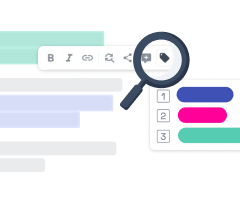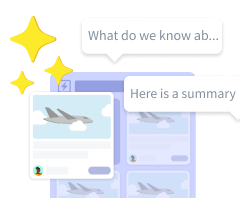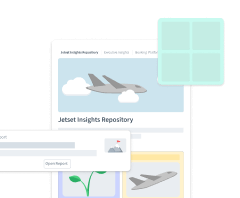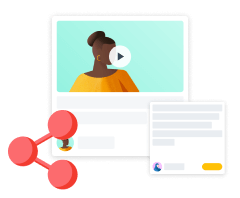Insights Magazine
The Insights is a dedicated stakeholder interface to easily access published Artifacts without being overwhelmed with raw data. Think of it as a personalized homepage you can tailor by highlighting key findings, providing context, and customizing layouts to ensure research is easy to understand and apply.
Additionally, the conversational AI search surfaces knowledge based on published Artifacts, so your stakeholders can get quick answers, follow up with more questions, and dive deeper into topics.
- Publishing Artifacts for the Insights Magazine
- How the Magazine works
- Customizing the Magazine
- Conversational AI search
- How it works
- Tips on structuring your data for best results
- Types of data that are searchable with AI
- Using the AI search
- Magazine settings
- General settings
- Magazine access
- AI Search
- Multiple Magazines
Publishing Artifacts for the Insights Magazine
Once an Artifact is ready, you can publish it via , which means the Artifact gets accessible to your colleagues and stakeholders. You can find more information on publishing Artifacts here: Publishing Research Findings.
You can view all published Artifacts by clicking at the bottom of the Insights Magazine.
How the Magazine works
Product managers, designers, management, and other stakeholders you invite will be able to explore published research findings in the Magazine.
The Insights Magazine consolidates what were previously known as the Stakeholder Repository and Research Magazine. With this update, all content is now accessible at app.condens.io, and any links to repo.condens.io will automatically redirect to the new Magazine. Conversely, you can simply share the app.condens.io link with stakeholders.
Stakeholders can only access published Artifacts—both in the Magazine and through conversational AI search. Full-access stakeholders will continue to have access to raw data.
The Magazine is read-only for Stakeholders. They cannot make edits, but can read and write comments or be mentioned in an Artifact.
Stakeholders can use the conversational AI search, Artifact Information Fields and Project Information Fields to find what they are looking for.

If you want to share the results of a single Project, you might use the shared Artifact instead.
Customizing the Magazine
The Team plan offers customization for up to two Clusters, while the Business and Enterprise plans provide unlimited customization.
By default, the Insights Magazine contains a general description of how it works, as well as your Featured and Newest published Artifacts.

To truly make the Magazine your own, you can use an abundance of customization options to tailor it to your stakeholders. In the upper-right corner of the Magazine, you will find the button. Once clicked, it enables you to:
Change the cover image.
Adjust layouts using text, headings, lists, callouts, quotes, columns, and tables.
Feature specific Highlights, Artifacts, Clusters, and Smart Clusters.
Embed images, files, or external content from integrations to provide deeper context.
To preview how the Magazine looks from the stakeholders' perspective, you can always click the menu next to the button to .
The Insights Magazine is your stakeholders’ gateway to valuable findings. A well-structured, tailored Magazine not only leaves a great first impression but also encourages stakeholders to return, explore, and engage with your research.
Let's explore practical advice to help you organize content, personalize the design, and create a repository experience that’s both intuitive and impactful.
Step 1: Plan the structure
A well-thought-out structure helps stakeholders quickly find the information they need. Consider how to best organize the content based on their roles and interests:
By products or services: Group findings under categories that reflect your organization’s offerings.
Example: Insights categorized under “Enterprise App” or “Consumer App.”
By teams or roles: Organize content so that stakeholders from product, design, marketing, or other teams can easily access insights relevant to their work.
Example: Dedicated sections for “Product Strategy” or “Design Improvements.”
By research areas: Use categories such as usability, customer pain points, or user behavior to help stakeholders explore topics of interest.
Example: “Common User Frustrations” or “Customer Journey Insights.”
Step 2: Add a personal touch
Once you’ve planned the structure, give your Magazine a look and feel that reflects your organization's visual identity and resonates with your audience. Use branding elements like header images, colors, and custom layouts to create a familiar, engaging interface. These small tweaks help create a more enjoyable experience for your stakeholders.


Recommended cover image dimensions are 1050x280 pixels.
Step 3: Create an onboarding section
Provide clear instructions to help stakeholders navigate insights with confidence.
An onboarding section at the top of the page including a welcome message and relevant resources should provide a great start. You can add information such as:
A short introduction explaining the purpose of the Magazine and what stakeholders can expect to find.
Highlight the structure and content sections of the Magazine.
Tips on how to use the AI conversational search, leave comments, and browse sections.
Short video tutorials to demonstrate searching and navigation.
A guide or FAQ addressing common questions in the form of a dedicated Artifact.
Support contacts in case stakeholders need additional guidance or need support.
If your organization uses other knowledge-sharing platforms like SharePoint, Confluence, or Google Drive, link to these to show how the repository fits into your broader ecosystem.
Step 4: Populate with content
A well-populated Magazine keeps stakeholders engaged. Launching with just a few insights may discourage them from returning, so aim to offer a variety of useful findings.
As a starting point, aim for 8-10 Artifacts representing different aspects of your research. These may span usability test reports, persona overviews, common user pain points, or customer interview summaries.
To make your content engaging and usable, we suggest you to:
Feature key findings that support active projects or strategic goals.
Include feature requests or recurring product feedback to inform prioritization.
Highlight positive quotes or testimonials from customers to inspire and motivate teams.
Add visuals or embedded content like charts, screenshots, or videos to enhance understanding.
Use a combination of text, headings, columns, lists, and tables to enhance readability and navigation.
Conversational AI search
The AI-powered conversational search in the Insights Magazine helps stakeholders find research-based answers quickly and intuitively.
By allowing users to ask natural-language questions, follow up for more insights, and access past conversations, it improves how research data is explored. The search bar is always visible at the top of the Magazine, ensuring easy access throughout the user experience.
How it works
The conversational search is designed specifically for research retrieval, not for general-purpose AI tasks. That means AI can only deliver answers based on published Artifacts, taking the semantic meaning of queries into account:
It only retrieves information that exists within published Artifacts, but does not analyze raw data, perform new interpretations, or generate conclusions not explicitly documented in the research—even if information from multiple Artifacts are aggregated.
If no relevant Artifact exists, the AI will inform you and may suggest a related question.
The AI maintains conversational context, allowing users to follow up with related questions. It can reference previously mentioned Artifacts to provide additional details.
Raw data is excluded to prevent cherry-picking or misinterpretation, ensuring stakeholders see only curated insights.
If generative AI is disabled in your workspace, you will still be able to use the standard search.
Tips on structuring your data for best results
To ensure accurate and relevant search results, make sure your Artifacts are clearly structured and semantically rich. While every team works a bit differently, here are some general practices we recommend for improving search relevance:
Use clear, descriptive titles for Projects and Artifacts that reflect the main topic or research question (e.g. “Usability testing – onboarding flow (May 2025)” is more helpful than “Round 2 test”).
Document insights explicitly in text, rather than relying on context or visuals alone. AI search performs better with written, interpretable insights. If you also include visuals, ensure there’s accompanying written explanation of what the visual shows.
Use headings and formatting within Artifacts to highlight themes, participant quotes, or takeaways. Structured text is easier for the AI to interpret and return in relevant snippets.
Use the Project and Artifact Information fields (like Goals, Method, Participants) consistently. In some cases, Condens AI will automatically pick up on them as relevant filters, and other times, stakeholders can use them to manually filter results.
Write in plain language and avoid internal jargon where possible, especially if your stakeholders aren’t deep in UX research themselves.
Types of data that are searchable with AI
Condens AI can interpret a variety of content types directly displayed within the platform. This includes:
Embedded PDF and PPT files
Images, charts, graphs, and infographics if they are part of an uploaded PDF or slide deck
Charts created directly in Condens and embedded in Artifacts.
However, certain content types are not searchable by Condens AI:
Charts, images, or infographics embedded as standalone images or screenshots within Artifacts. Condens only displays a view of these elements without having direct access to their underlying data.
Excel and CSV files, as their primary function is to store raw data rather than present information in a format the AI can interpret for search purposes.
Any "embeds" from external tools such as Figma, Miro, or Tableau are not searchable due to the aforementioned data access limitations.
Using the AI search
To get the most out of AI search, it’s helpful to be specific with your queries. The AI is designed to interpret different phrasings, including synonyms, and match them to published research. That means your stakeholders don't need to use the exact keywords or meta information you use to find information, but can rather use natural language.
Asking general questions to explore insights
These questions help surface existing knowledge and insights within published Artifacts. For example, these could be detailed questions like:
“What are the key findings from the latest project?”
"What usability issues are affecting enterprise customers?"
“Which features receive the most complaints?”

For questions involving quantitative data (e.g., number of feature complaints, survey results), ensure the data is documented in text form. The AI can't interpret images such as charts or graphs, so write down key values in tables, descriptions, or summaries.
Locating specific information
The AI search also works for retrieving specific research evidence. Use these types of queries to surface particular reports, Highlights, or other structured research content.
Show me reports on travel bookings sorted by date.
Show me all reports on accessibility testing.
Show me some Highlights where feature XYZ is mentioned.
Searching with simple keywords
The AI search also works with simple prompts. If you only type a keyword—such as onboarding or accessibility—the system will search for relevant mentions across all published Artifacts. While this method is effective for broad exploration, more detailed questions naturally provide more precise results.
To search for specific keywords within published Artifacts, make sure to use quotation marks.
No match is found
If the AI can’t find an exact match, it will let you know. This may happen if an answer is not covered by any published Artifacts.
However, if there is an alternative phrasing that might be better suited to surface an insight, AI may suggest related questions or guide you to relevant Artifacts to continue the search.

Combining questions and filters
You can refine any type of query by applying filters based on Artifact and project information fields. This allows for highly targeted answers, particularly if your research is well-organized with metadata. As soon as you start typing your query, the option to will be enabled. For example:
You could ask“What locations do adventure travelers prefer?” and apply a location filter for USA to focus the search.
Alternatively, frame your query as “What locations do adventure travelers from the USA prefer?” The AI will recognize USA as a location and adventure travelers as a Persona, for instance, and suggest these filters (if those fields are available in the Artifacts) to narrow down results.
Keyword search
Additionally, you can switch to the standard keyword search at any moment by clicking on the magnifier glass icon and selecting the Keyword search from the drop-down menu.

Magazine settings
Every Magazine has its own settings related to the scope of published Artifacts available in the Magazine, and likewise available through the conversational AI search.
Access Magazine settings by clicking the in the upper-right corner of a Magazine, or go to and then click .
General settings
In General settings, you can limit the scope of the Magazine and AI search to ensure the right insights are accessible through each Magazine.
Use filters to define which Artifacts should remain visible to your stakeholders. For example, you could limit their availability by Artifact type, published date, or any other Artifact and Project information fields.

On the right, there is an indicator showing exactly how many Artifacts match the set filters. Hover over it to see the exact Artifacts that would remain accessible via the Insights Magazine if you applied these scope limitations.

If you apply filters, data embedded in Artifacts may still be visible if the Artifact itself matches the filters, even if the embedded data does not.
Deleting a Magazine
Additionally, you can delete the Magazine. Beware that deleting a Magazine will cause all stakeholders to lose access to its Artifacts and the search funtionality. Deleting it, however, does not impact or delete any published Artifacts directly.
Magazine access
Decide who can access your Magazine either by adding specific Users or entire User Groups.

AI Search
To help your stakeholders have a quicker start to using the conversational AI search within the Insights Magazine, you can personalize their experience.

Show a custom search hint
Set a predefined message that appears before users initiate an AI-powered search. This can help guide them on how to phrase their queries effectively, highlight the types of insights they can expect, or clarify any limitations of the AI-generated results.
Use this space to suggest best practices like. For example: “Use clear and specific keywords for better results”. This ensures users have a clear understanding of how to make the most of the search functionality.
Show search recommendations
Provide new stakeholders with suggested search topics, helping them discover relevant content quickly. These recommendations act as a starting point for exploration, making it easier to engage with the AI-powered search and surface meaningful insights right away.
You might suggest searches on commonly explored topics like “Recent findings on user onboarding” or “What challenges were identified in usability testing” to ensure they make the most of the search experience from the start.
Multiple Magazines
Business plan users can create up to 3 Magazines, while Enterprise users can have unlimited Magazines.
Multiple Magazines allow you to curate content for different purposes. Whether that's reaching specific audiences like product, design, or leadership teams, or focusing on distinct topics such as a product, service, or research area.

This flexibility ensures stakeholders only see content that’s relevant to their roles and interests, improving engagement and collaboration.
Creating a new Magazine
There are two options to create a new Magazine. When viewing an existing Magazine, click in the upper-right corner, and then . Or, go to , select , and click
Add second Magazine.
In both cases, what follows is a few easy steps to help you define the new Magazine:
Give your Magazine a title and customize the layout. You can always edit the Magazine later, so don't feel pressured to make it perfect immediately.
Define the scope of Artifacts available through the Magazine, and therefore the conversational AI search.
Define access settings.
Customize the AI search with custom search hints and recommendations.





